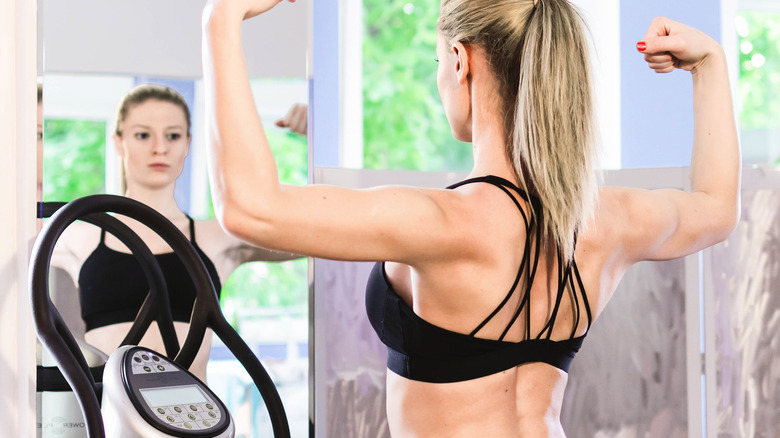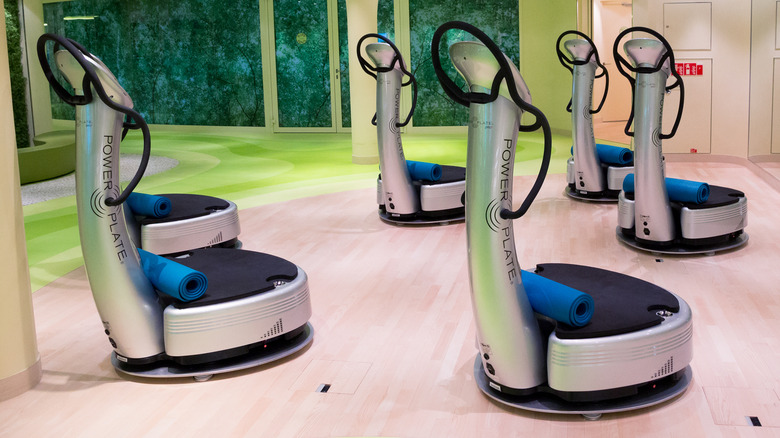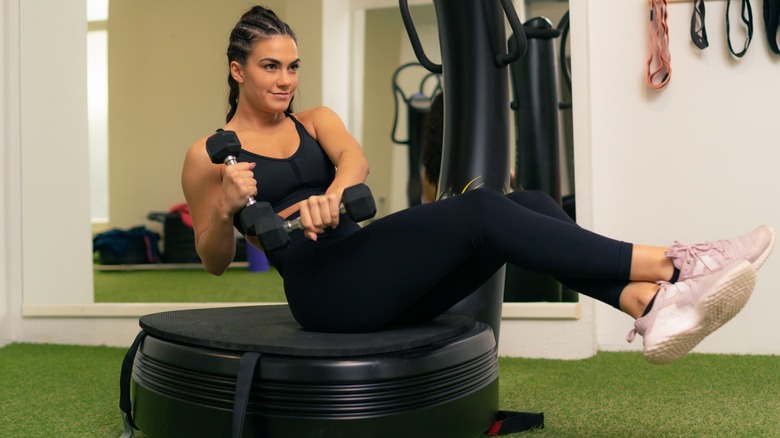What Do Vibration Platforms Actually Do?
Whether you want to keep fit, lose a few pounds, or build lean mass, you must commit to regular exercise and watch your diet. But it's also easy to hate working out. Just think about how you feel after a strenuous workout. Every muscle in your body hurts, and you can barely move. Others simply might not have time to hit the gym and stick to their training plan. Given these scenarios, it's no surprise that more and more people are seeking alternative ways to get fit. For example, vibration platforms have popped up in fitness centers and wellness clubs worldwide. Some models are also designed for home use, making it easier to squeeze more exercise into your schedule.
Vibration machines, such as the popular Power Plate, cause your muscles to contract and relax repeatedly (via WebMD). This process is supposed to build muscle strength, improve circulation, and speed up recovery from training. Manufacturers also say that vibration platforms can lead to greater flexibility and range of motion, while increasing bone density. But can you trust these claims?
The experts interviewed by WebMD agree that vibration machines may have some benefits, especially for those who cannot exercise. If, say, you have a knee injury or severe back pain, you could use these gadgets to maintain muscle tone. "I've seen some remarkable results in terms of bone density — working better than conventional exercise," physical therapist Ben Quist told WebMD. However, there's still a lot of debate around these potential benefits.
This is how vibration platforms work
Whole-body vibration has emerged as an alternative to strength training. This technology works by sending vibrations through the body, which in turn stimulates nerves and muscles. Over time, it may improve nerve function, muscle strength, balance, and other health markers (via the European Review of Aging and Physical Activity). In clinical trials, whole-body vibration decreased fall risk and increased muscle power in seniors. Some studies also suggest that it may enhance both upper and lower body flexibility in as little as two months. However, these findings may be subject to publication bias and require further investigation.
Vibration machines are relatively easy to use. All you need to do is to stand on the platform with your knees bent at 30 degrees, explains Quist (via WebMD). Most devices vibrate about 30 times per second, challenging your balance. "This, in turn, activates the 'stress reflex' — an extremely rapid muscle contraction," says Quist. Some machines also provide enough space for exercise, so you can squat or work your arms while on the platform.
Their effectiveness depends on several factors, such as the intensity of vibrations, per Healthline. Generally, up and down vibrations lead to faster muscle contractions and better results. Just make sure you have realistic expectations. Vibration platforms are unlikely to match the benefits of conventional exercise, per sports medicine specialist Gerard Varlotta, D.O. (via WebMD). He recommends using them as "an adjunct to your normal exercise routine" to reap their benefits.
Can whole-body vibration help you get leaner?
CardioTech and other manufacturers claim that vibration platforms can boost your metabolism and speed up weight loss while reducing cellulite. Unfortunately, these statements lack scientific evidence. The Mayo Clinic explains that whole-body vibration may improve muscle strength, but it's unlikely to help you get leaner unless your diet is in check. It also appears to work best when used alongside regular exercise.
A 2019 review featured in the Journal of Musculoskeletal and Neuronal Interactions analyzed several studies on the role of whole-body vibration in weight loss. This technology has been shown to reduce body fat mass, but its effects were insignificant. The number of calories burned was similar to the energy expenditure associated with moderate-intensity walking. Note that most studies were small and of short duration, so it's difficult to assess their accuracy.
Ultimately, vibration platforms are not a silver bullet for weight loss or sports conditioning. This type of equipment may help to some extent, but it has its limitations. "If you think of conditioning as a toolbox, there are lots of tools," William J. Kraemer, a professor of kinesiology, told The New York Times. "But when companies are selling something, they want to pretend that one tool does everything."


